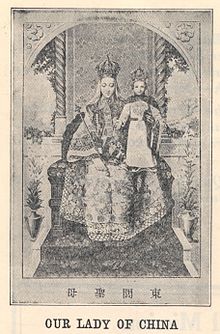Our Lady of China
| Our Lady of China The Great Mother of China 中 華 大 聖 母 | |
|---|---|
 | |
| Location | Chiayi, Taiwan |
| Date | 1976 |
| Type | wood statue |
| Approval | Pope Francis |
| Shrine | National Shrine of Our Lady of China, Meishan county, Taiwan |
| Patronage | Chinese peoples |
| Attributes | Madonna and Child as the Empress Dowager and Son |
| Feast day | Second Sunday of May |
Our Lady of China, the Great Mother (Simplified Chinese: 中华大圣母, Traditional Chinese: 中華大聖母, pinyin: Zhōnghuá Da Shèngmǔ) is a Roman Catholic title of the Blessed Virgin Mary associated with an alleged Marian apparition in Donglu, China in 1900.
In 19 February 2021, Pope Francis granted a decree of Canonical Coronation for a Marian image decreed as Madonna and Child, presently venerated at the National Shrine of Our Lady of China in Chiayi, Taiwan. The expected date of coronation is yet to be announced.
History[]

During the Boxer Rebellion, a great number of soldiers attacked the village of Donglu, Hebei. The village consisted of a small community of Christians founded by the Vincentian Order of priests. Pious legends claim that the Blessed Virgin Mary appeared in white, and a fiery horseman (believed to be Saint Michael the Archangel) who chased away the soldiers.
The local priest, Father Rene Flament of the Congregation of the Mission hired a local French painter in Shanghai to make a Marian statue with similar to the Chinese dowager Empress Ci Xi. This image was based in the Marian image of “Our Lady of Laeken” venerated in the Church of Our Lady of Laeken in Brussels, Belgium. The Donglu statue was later destroyed in 1966 during the Cultural Revolution.
Accordingly, Donglu became a place of pilgrimage in 1924. The image was blessed and promulgated by Pope Pius XI in 1928.[1] At the close of the 1924 Shanghai Synod of Bishops in China, the first national conference of bishops in the country, Archbishop Celso Costantini (剛恆毅), Apostolic Delegate in China, along with all the bishops of China, consecrated the Chinese people to the Blessed Virgin Mary. In 1941, Pope Pius XII designated the feast day as an official feast of the Catholic liturgical calendar.[2]
In 1973, the Chinese Bishops conference, upon approval from the Holy See, placed the feast day on the vigil (day preceding) of Mothers Day (the second Sunday of May).[2]
In 1989, a painted canvas of the same Madonna with Child Jesus dressed in golden imperial robes was recreated, now enshrined at the altar of the parish. In 1976, another statue was reconstructed in Taiwan now venerated in the “National Shrine of Our Lady of China”, which was constructed in 1913. This Marian image merited a decree of Pontifical coronation from Pope Francis in 19 February 2021.
Veneration and controversy[]

A mosaic rendition of Our Lady of China exists within the Basilica of the National Shrine of the Immaculate Conception in Washington D.C. established in 2002. [3]
Controversy arose due to the Marian iconography not being officially sanctioned by the Holy Office for religious propagation. Adding more political issues, a Chinese Cardinal Thomas Tien Keng-Hsin sanctioned this variant image for a religious prayer card for the persecuted in China, and was widely promoted in America and Canada.[4][a]
References[]
Citations[]
- ^ "Our Lady, Queen of China", St Dominic's Priory, Macau
- ^ a b "Our Lady of China", The Cardinal Kung Foundation
- ^ Basilica of the National Shrine of the Immaculate conception
- ^ ""Our Lady of China", The Marian Library, University of Dayton". Archived from the original on 2013-07-30. Retrieved 2014-08-17.
- ^ R.C. Our Lady of China Chapel
Notes[]
- ^ Several churches, chapels, and pastoral centers around the world, predominantly those focused on ministry to Chinese-speaking Catholics, have adopted the name, including a mission in Washington, D.C. St. Genevieve's Chinese Roman Catholic Church, Fresno, California also honors Our Lady of China. There is a Chapel of Our Lady of China in the Diocese of Brooklyn, New York.[5] In the Philippines where the Chinese and Chinese-Filipinos comprise the biggest ethnic community, the Santa Maria Parish of the Jesuit Fathers, located at the old Ateneo campus in Iloilo City, is the only church in the country dedicated to Our Lady of China that is duly recognized by the Catholic Bishops Conference of the Philippines (CBCP). The Archdiocesan Shrine of the Most Sacred Heart of Jesus in D. Jakosalem, Cebu City, still by the Jesuits, also houses an image of Our Lady of China. It used to be dedicated to this title of Our Lady until the patronage was changed to the Sacred Heart of Jesus. Although Binondo in Manila is the country's Chinese capital, both the Minor Basilica of Saint Lorenzo Ruiz (Filipino Parish) and the Binondo Chinese Parish does not house an image of the Chinese Madonna (as clarified by representatives of both parishes). As of October 2020, images of Our Lady of China (sometimes referred to as Our Lady of Sheshan) can be found at the following Chinese-Filipino Catholic communities: Santa Maria- Our Lady of China Parish, Iloilo City; Ateneo de Iloilo - Santa Maria Catholic School, Iloilo City; Archdiocesan Shrine of the Most Sacred Heart of Jesus, Cebu City; Sacred Heart School - Ateneo de Cebu, Mandaue City; Saint Peter the Apostle Parish, Paco, Manila; Lorenzo Ruiz Mission Society Seminary, Manila; Saint Jude Catholic School (National Shrine of Saint Jude Thaddeus), Manila; St. Jude Thaddeus Parish, Legazpi City; Queen of Peace Parish, Bacolod City; Resurrection of the Lord Parish, Iligan City; and Our Lady of Lourdes Parish in Butuan City (P. Burgos Street).
Sources[]
External links[]
- Catholicism in China
- Marian apparitions
- Titles of Mary